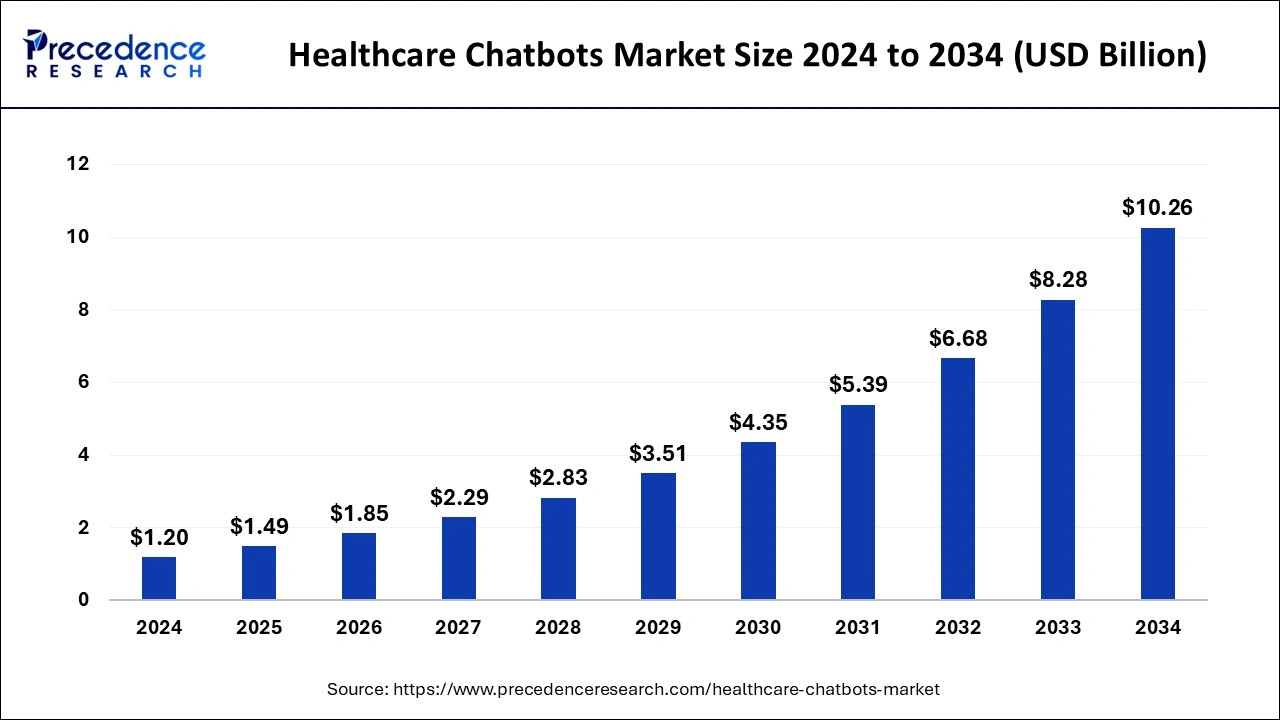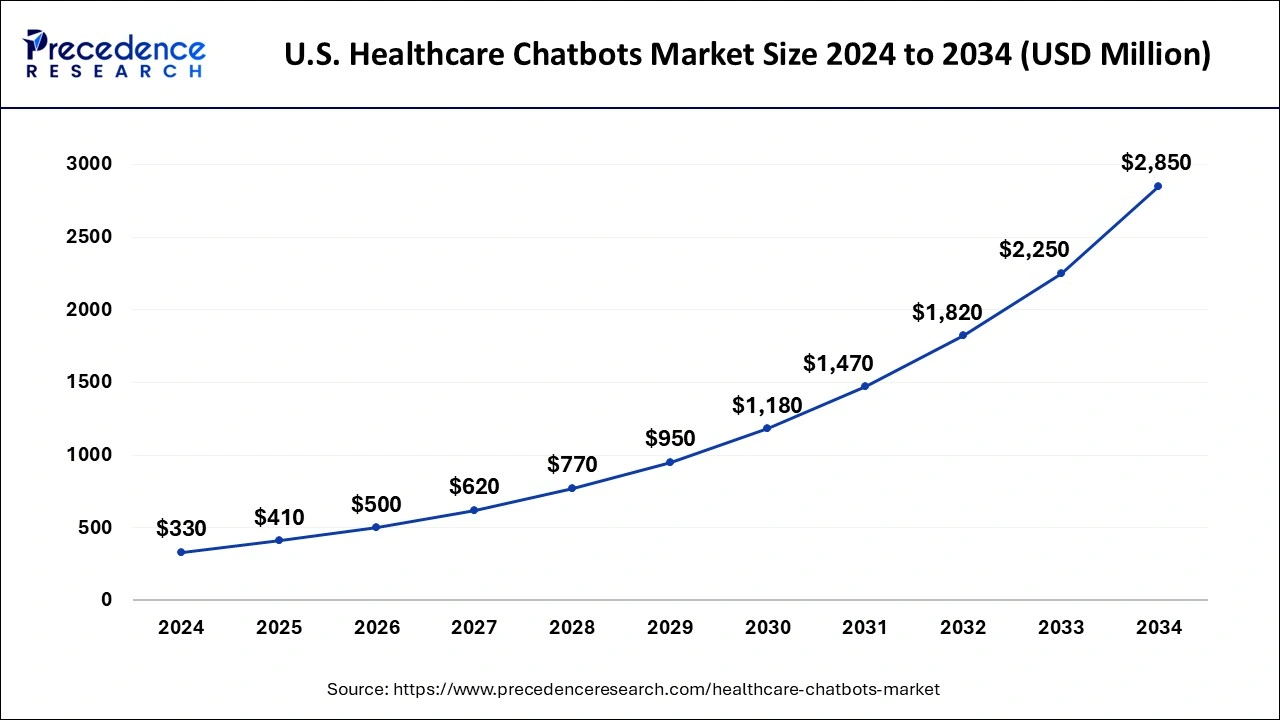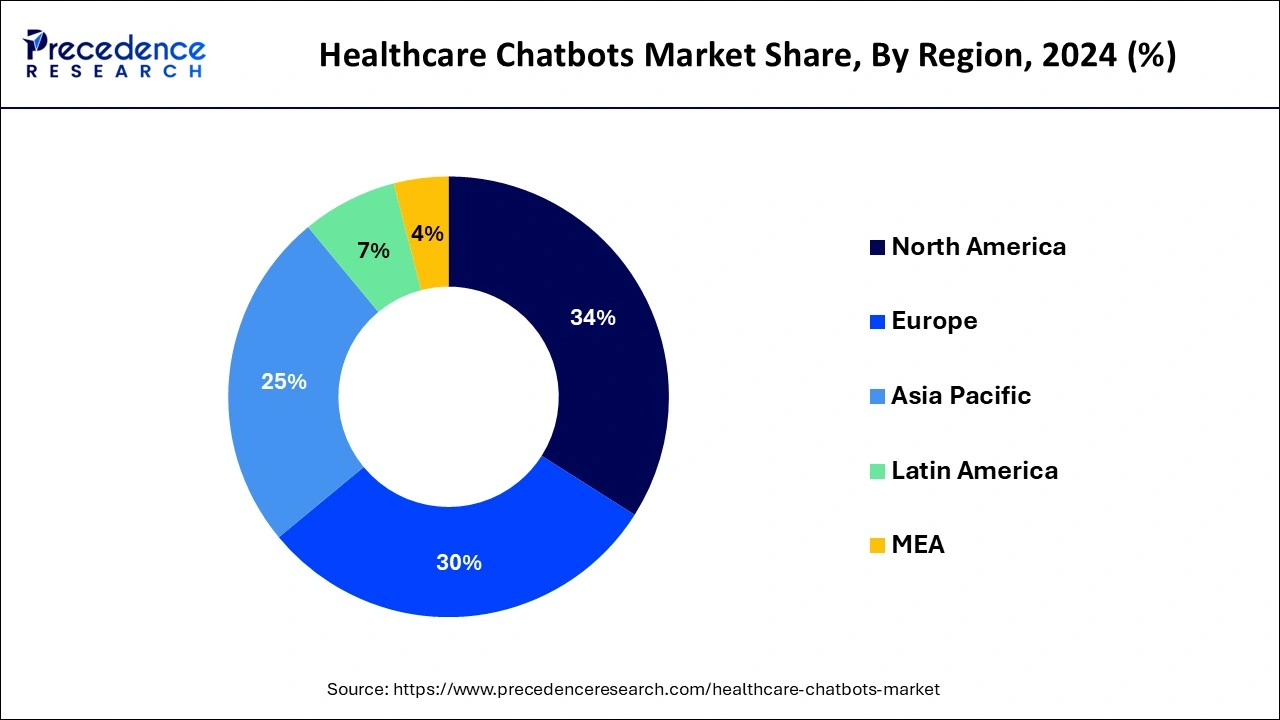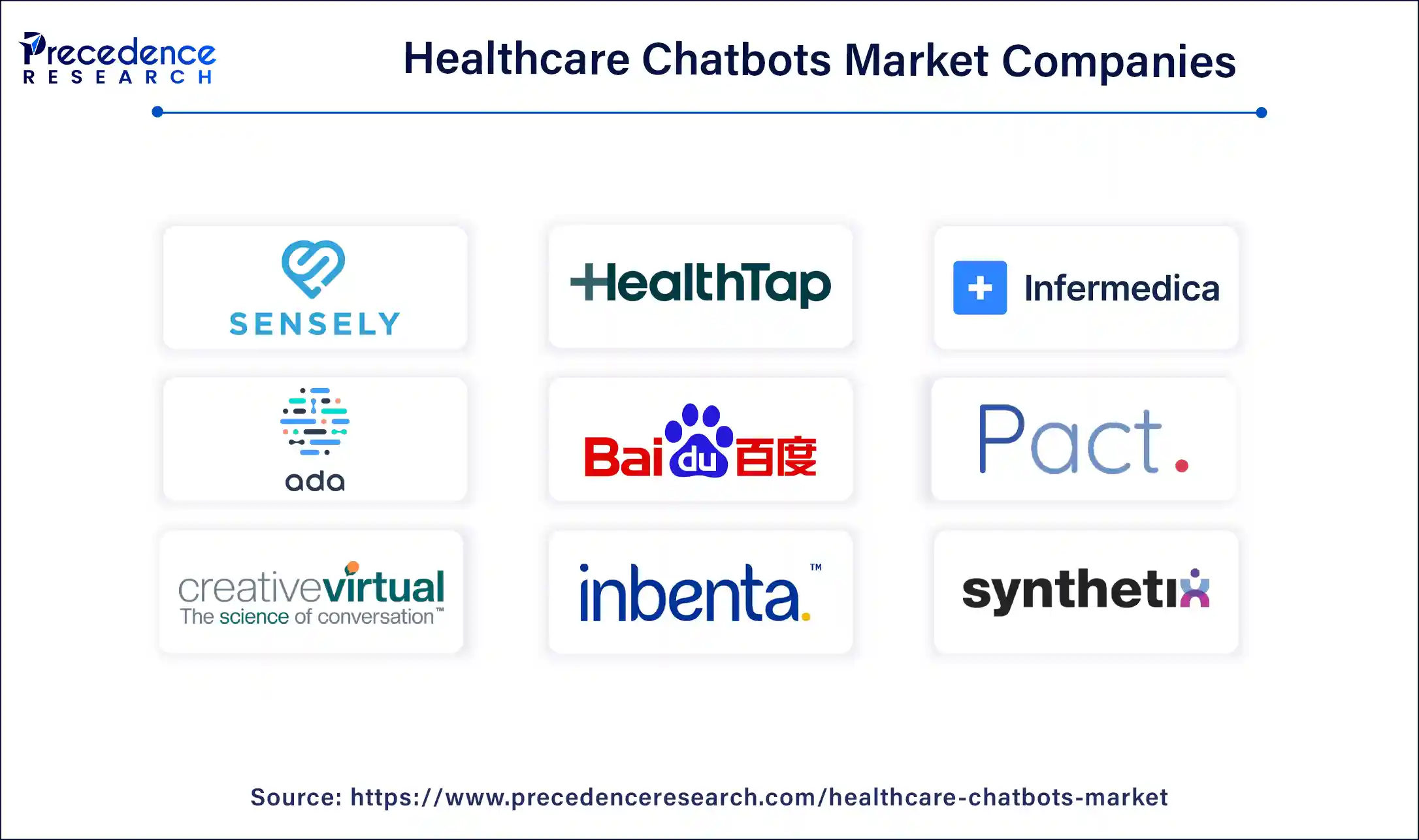January 2025
The global healthcare chatbots market size is calculated at USD 1.49 billion in 2025 and is forecasted to reach around USD 10.26 billion by 2034, accelerating at a CAGR of 23.92% from 2025 to 2034. The North America healthcare chatbots market size surpassed USD 410 million in 2024 and is expanding at a CAGR of 24.05% during the forecast period. The market sizing and forecasts are revenue-based (USD Million/Billion), with 2024 as the base year.
The global healthcare chatbots market size was estimated at USD 1.20 billion in 2024 and is anticipated to reach around USD 10.26 billion by 2034, expanding at a CAGR of 23.92% from 2025 to 2034.

AI in healthcare is the total game changer, especially in mental health support applications. AI has gained major respect in healthcare due to its modern performance and support in major surgeries, ethics, optimizations, and patient health monitoring. However, the integration of AI in healthcare chatbots for virtual therapy is the highlighted innovation that happened in 2024. AI-powered chatbots are able to provide support and guidelines by monitoring the behavior of the patients. AI-enabled chatbots not only help to detect diseases and require diagnostic treatment solutions but also help to provide emotional support to the patients through therapy sessions. The advanced AI-powered chatbots are able to read facial expressions and voice patterns, which further helps to identify current conditions and emotions of the patients. With the help of AI integration in chatbots, healthcare sectors are focusing on improving patient mental health
The U.S. healthcare chatbots market size was evaluated at USD 330 million in 2024 and is predicted to be worth around USD 2850 million by 2034, rising at a CAGR of 24.06% from 2025 to 2034.

Based on region, the Global Market for Healthcare Chatbots is segmented into North America, Europe, Asia Pacific, and the Rest of the World. North American dominated the global healthcare chatbots market with the largest market share of 34% in 2024. and is anticipated to grow at the fastest rate due to factors such as the expansion of conglomerate-embedded chatbots of social media, the rise in the use of mobile apps for gathering healthcare information, and significant investments made by developers of digital healthcare to advance the use of healthcare bots.

Because of its high literacy rate and technologically sophisticated populace, this region serves as the primary market. Furthermore, chatbots' realism and informational value have increased due to close cooperation between medical institutions and technology service providers. Additionally, the expansion of the healthcare business is being fueled by rising systemic investment. Another regional area that is expanding quickly is Asia-Pacific. Rising technological advancements and an increase in smartphone penetration are the main growth drivers. Additionally, expansion is being fuelled by expanding internet access and increasing literacy rates. The Middle East and Africa section is anticipated to experience moderate growth during the forecast period.
Growing patient waiting time and a lack of effective patient engagement, rising use of healthcare chatbots, healthcare chatbot's increasing demand as a result of increasing demand for virtual health assistance, and growing numbers of collaborative efforts between healthcare providers are all contributing to the growing demand for virtual health assistance, which is a crucial factor driving the market growth. Additionally, throughout the forecast years, the market for healthcare chatbots would see new opportunities due to the growth of chatbots focused on social networking platforms and the development of cloud-based models.
| Report Coverage | Details |
| Growth Rate from 2025 to 2034 | CAGR of 23.92% |
| Market Size in 2025 | USD 1.49 Billion |
| Market Size by 2034 | USD 10.26 Billion |
| Largest Market | North America |
| Base Year | 2024 |
| Forecast Period | 2025 to 2034 |
| Segments Covered | By Component, By Application, By Deployment, By End-User |
| Regions Covered | North America, Europe, Asia-Pacific, Latin America and Middle East & Africa |
Utilization of intelligent devices
Intelligent device use and expanding internet availability are significant industry drivers. A lack of experience in chatbot development, in addition to growing ignorance and misunderstandings, will further hamper the expansion of the Healthcare Chatbot Market during the forecast period. Rising worries about data privacy are the primary reasons obstructing the market growth. As a result of recent advancements in digital technology, numerous healthcare organizations have started utilizing various digital marketing strategies. The market for healthcare chatbots is likely to increase since phone and messaging services, a component of chatbots, were incorporated into these plans.
Privacy challenges
Medical chatbots are helpful for the economy, but there are obstacles to their global market expansion. The user's right to privacy is the most crucial factor, and some patients might be reluctant to divulge personal information to chatbots. The lack of trained healthcare IT employees is another issue that has led to cyberattacks. These elements are inhibiting the growth of healthcare chatbots in the global market. Business growth is, however, constrained by problems like a lack of experience, limited interaction options, and data privacy worries. The market's growth will be constrained by growing data privacy concerns. Throughout the forecast period, the demand for healthcare chatbots will also encounter new difficulties brought on by a lack of expertise in chatbot creation and rising misunderstandings.
Natural language processing
The natural language processing is helping to advance healthcare chatbots by improving clinical documentation, as their integration with chatbots helps to provide automated chart review and clinical decision supports. Natural language processing helps to read patient emotions and understand their preferences. Additionally, the ability of natural language processing enables chatbots to provide quick and sensible responses and support to the audience according to their state of emotions as they emerge in the market. The healthcare sector has increased demand for NLP integration with the chatbots to improve patient mental health and decision-making services for the healthcare professionals. With ongoing research & developments and leverage of advanced technologies, the NLP integration with chatbots is expected to witness spectacular transformation in the forecast period.
Based on components, the market is segmented into Services, Software, and Others. The software segment has held a major market share of 64% in 2024. The Healthcare Chatbots Market for Software also includes revenue from chatbot solutions, designing, and programming but excludes consultancy, installation, system integration, support, and maintenance. Most chatbot providers offer a freemium version that may be upgraded to a monthly or yearly plan, and they often rely on subscription-based pricing structures to generate revenue. A rise in smartphone use and a better understanding of self-monitoring methods for managing treatment and diagnoses contribute to the expansion of the chatbot software sector.
Symptoms check medical & drug information help, monitoring, appointment scheduling, and other applications make up the market's application-based segmentation. The symptoms check segment contributed the biggest market share of 39% in 2024. Growing smartphone and internet usage among patients and healthcare professionals are driving the demand for such solutions. Due to the need to reduce patient wait times and better utilize healthcare resources, appointment scheduling, and monitoring are predicted to expand at the fastest pace throughout the projected period. Some of the most widely used primary care symptoms checker chatbots are Babylon Health, Ada, Buoy Health, and Your. MD.
The market is divided into On-premise Model and a Cloud-based Model, depending on how it is deployed. The cloud-based model segment contributed the highest market share of 34% in 2024 and was the fastest-growing category during the predicted period because of the numerous advantages of various chatbots. Compared to on-premise chatbots, cloud-based chatbots are easier to use and require less modification. Therefore, the factors mentioned above support the expansion of the healthcare chatbot market.
The market is divided into healthcare payers, providers, patients, and other end-users. Patients are the primary users of healthcare chatbots, making them the majority of end users. The ease of seeking professional assistance is one of the driving reasons behind innovation. Furthermore, quick resolution of patient complaints and straightforward answers to many challenges encourage patient acceptance.

By Component
By Application
By Deployment
By End-User
By Geography
For inquiries regarding discounts, bulk purchases, or customization requests, please contact us at sales@precedenceresearch.com
No cookie-cutter, only authentic analysis – take the 1st step to become a Precedence Research client
January 2025
December 2024
February 2025
April 2024